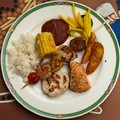Common wisdom says one such ideal pairing is food and wine. Not all foods and all wines, of course. As any foodie will tell you, red wines and seafood don’t mix, while delicate whites are easily overpowered by a medium rare steak. And a good sliver of camembert will usually smooth out any cabernet. But beyond the obvious no-nos, most sommeliers see food-wine pairing as more of an art than a science, with no hard and fast rules.
Do they have chemistry?
Well, no longer. It seems science is pushing itself to the front again. (Diluted wine with meals originally served a sanitary purpose: to disinfect meat gone slightly bad from a lack of refrigeration.) Japanese scientists have in October published results explaining why some red wines do work with seafood: if a red does not have iron in it, then the fishy aftertaste of a bad bordeax-bream pairing can be avoided. If even trace amounts are added to any wine while dining on scallops, voilá, a terrible meal.
It also turns out that combining red wines and red meat is not only good, but also good for you. Red wines containg polyphenols, powerful antioxidants that are not absorbed by the body easily. Meanwhile, the digestion of fat-rich red meat produces two byproducts (malondialdehyde and hydroperoxide) which are toxic to cells. However, when you have both in your stomach, it acts as a bioreactor where polyphenols are not only capable of binding free radicals but killing toxic stuff as well, american scientists found.
And it is not just the scientists, but chefs as well. Enlisting scientific methods and chemistry labs in the search for perfect flavor-combinations has been around for a while. Molecular gastronomists like Ferran Adrià of El Bulli in Spain and others analyse the flavor compounds of food and use the results to mix them in surprising combinations based on the two foods sharing a flavor-compound. Celebrity chef Heston Blumenthal of the British restaurant Fat Duck discovered, for example, that white chocolate and caviar have a compound in common: trimethylamine. Carrot and violet should go because both have ionone. Oyster and kiwi share methyl hexanoate. Coffee might make a good substitute for broth as it also has 2-furfurylthiol and 2-methyl-3-furanethiol. Liven and jasmine, yum.
The science of drinking
But this year, the search for perfect matches is encreasingly including beverages. Heston Blumenthal is researching how the drink of British grandmothers, sherry complements foods. Together with Professor Don Mottram of Reading University, he found that dry sherries hold a group of compounds known as diketopiperazines (DKPs) that can accentuate and carry the taste of some umami-rich foods such as shitake mushrooms and Parmesan cheese. (Umami is the fifth taste beside sweet, sour, salty and bitter. It is also known as savoury.) For instance, eugenol was found in both Fino Sherry and cloves, making them a match. “One of the big revelations was trying an Amontillado with peach and it seemed to be that the Sherry made the peach more peach-like, which is amazing,” Blumenthal commented to a journalist.
A Canadian sommelier of 20 years is quickly reaching superstar status in the molecular gastronomy world due to his scientific investigation of wine-food pairings. His book Papilles et molécules (Tastebuds and Molecules), published in the summer, received heady accolade from Adrià himself (who has, incidentally introduced a beer to go with food). Adrià praised it as “a paramount work, the foundation stone, the first step into a new world that is now open wide in all its splendour to those who love gastronomy.” François Chartier also mostly uses similarity as the basis for pairings, leading to combinations such as oak-aged wines with pork, traditionally linked up with fruity reds and rosemary with moscato, riesling and gewurztraminer, which are seldom paired at all.
One food-wine pairing I liked in Budapest was Philippe of Philippe Le Belge Restaurant and Sára Matolcsy, head of Etyeki Kúria Winery. It was a combination of known factors: the former is one of the more innovative French restaurants in Budapest, while the latter happens to be my favourite winery in Hungary. The menu had six wines to go with eight dishes with interesting combinations such as Chinese prawns in beer-batter with a pinot noir osé. Auvergne blue cheese, which usually takes a sticky-sweet red such as a port or a madeira was paired with a chardonnay, which made me happy.


